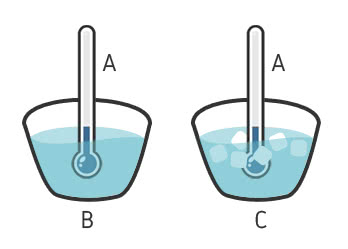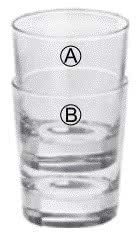Zero Law of Thermodynamics is that which deals with the conditions for two bodies (A and B) to achieve thermal equilibrium with a third body (C).
A thermometer (body A) in contact with a glass of water (body B) and, on the other hand, a thermometer in contact with a bowl containing water and ice (body C) obtain the same temperature.

If A is in thermal equilibrium with B and if A is in thermal equilibrium with C, then B is in thermal equilibrium with C. This happens even though B and C are not in contact.
This is what happens when we put two bodies with different temperatures in contact. Heat is the energy transferred from the body at the highest temperature to the body at the lowest temperature.
Let’s imagine a very hot cup of coffee. You are in a hurry to take it and then you need to cool down so you don’t get burned. So, add milk to coffee.
The temperature of the coffee (T 1 ) is higher than the temperature of the milk (T 2 ), ie T 1 > T 2 .
But now we have coffee with milk, whose temperature due to the contact of T 1 and T 2 , after some time, results in T 3 , which means that it has reached thermal equilibrium . So, we have to T 1 > T 3 > T 2 .
The temperature is influenced by the type of material with which it is made. In other words, the temperature depends on the thermal conductivity , higher or lower in different materials.
Thermometers were invented to measure temperature correctly, after all, sensory perception was not effective.
There are three temperature scales: Celsius (ºC), Kelvin (K) and Fahrenheit (ºF).
It should be noted that Law Zero of Thermodynamics was postulated after the first laws of thermodynamics, the First Law of Thermodynamics and the Second Law of Thermodynamics .
It was because it was necessary for the understanding of these laws, that it received a name that preceded them.
Solved Exercises
1. (UNICAMP) Efficient thermal insulation is a constant challenge to be overcome so that man can live in extreme temperature conditions.
For this, a complete understanding of the heat exchange mechanisms is essential. In each of the situations described below, you must recognize the heat exchange process involved.
I. The shelves of a domestic refrigerator are hollow gratings, to facilitate the flow of thermal energy to the freezer for […]
II. The only heat exchange process that can occur in a vacuum is by […].
II. In a thermos, a vacuum is maintained between the double glass walls to prevent heat from leaving or entering through [….].
In order, the heat exchange processes used to fill in the gaps correctly are:
a) conduction, convection and radiation.
b) conduction, radiation and convection.
c) convection, conduction and radiation.
d) convection, radiation and conduction.
Answer
Alternative d: convection, radiation and conduction.
2. (VUNESP-UNESP) Two identical glass cups, in thermal equilibrium with the ambient temperature, were kept, one inside the other, as shown in the figure.
A person, in trying to undock them, was unsuccessful. To separate them, he decided to put his knowledge of thermal physics into practice.

According to thermal physics, the only procedure capable of separating them is:
a) immerse cup B in water in thermal equilibrium with ice cubes and fill cup A with water at room temperature.
b) put hot water (above room temperature) in cup A.
c) dip cup B in cold water (below room temperature) and leave cup A without liquid.
d) fill cup A with hot water (above room temperature) and immerse cup B in ice water (below room temperature).
e) fill cup A with ice water (below room temperature) and immerse cup B in hot water (above room temperature).
Answer
Alternative e: fill cup A with ice water (below room temperature) and immerse cup B in hot water (above room temperature).
